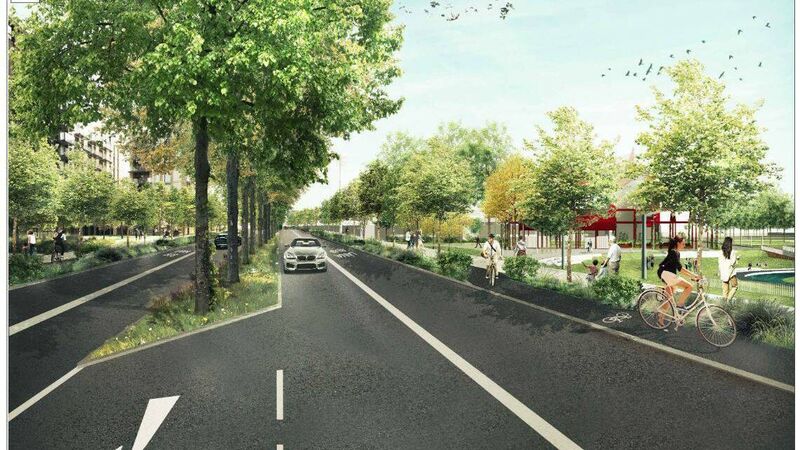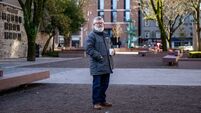Michael Moynihan: Another dual carriageway looms as we battle to keep green space in the city

An artist's impression of the proposed Monahan Rd extension scheme, looking north towards the river Lee.
Here's a puzzling one.
Eoin English of this parish broke a Cork-focused story over the weekend, though you might have missed it because you were probably like the rest of us, saying a couple of decades of the rosary that a few Italian lads would bury their penalties.
Eoin’s story focused on the southern end of the docklands part of the city, and what’s planned for that zone — specifically, plans for a new dual carriageway within the area.
“They [the plans] show how the proposed four-lane two-way carriageway will run for 400m from Monahan Rd,” he wrote, “at the existing junction with Marquee Road close to the entrance to the former Ford site and home to Live at the Marquee, where a new crossroads junction will be formed, towards the river Lee.
“From this new junction, the proposed road extension will run northeastwards, between the eastern boundary of the Live at the Marquee site and the northern boundary of the under-construction Marina Park, towards the river, passing to the northwest of Páirc Uí Chaoimh.
“And at this point, the road levels will be elevated above existing ground level to connect to the future Eastern Gateway Bridge which will link the south docks to the Lower Glanmire Road on the northern banks of the river Lee.
“The proposed Monahan Rd extension will have two eastbound and two westbound lanes, with a central reservation, verges, cycle tracks and footpaths.”
Where to begin with this?
One of the undisputed, hands-down victories of the lockdown was the decision to turn the Marina into a car-free zone, one of the best examples of life-gives-you-lemons, etc, on offer in recent years.
We’ve offered our congrats before to the council for its swift move here to facilitate people when we were all stuck within 5km of home.
The sense of freedom and ease when walking the Marina has become so strong so fast that you can’t help wondering why it took so long to create that little oasis in the city. When vaccinations cease in Páirc Uí Chaoimh, and there’s even less car traffic in the area, then it’ll get even better.
Or so you would have thought until reading Eoin’s news about a four-lane dual carriageway (“with a central reservation, verges, cycle tracks and footpaths” as well) being extended almost half a kilometre past the Monahan Rd.
This seems to run counter to the logic of having a new park in the Marina area, with a long pedestrianised road running parallel to the Atlantic Pond: are we only encouraging people to get out into the open air in these areas so long as that open air carries all the noise and fumes associated with a dual carriageway nearby?
There’s another argument against this notion of a dual carriageway idea which you might call the East Tremont argument.
When I heard about this plan I posted sarcastically on social media that Robert Moses had been the consultant involved.
Moses was the most powerful unelected official in New York for over 50 years, a civil servant who built bridges and highways all over that city and state, and whose staggering career is the subject of one of the greatest non-fiction books of all time, by Robert Caro.
Moses came to power in the twenties and was a powerful force for five decades, but his works are now linked with the savage deterioration of the standard of living in New York during the seventies, when the fruits of his policies came home to roost. Isolated communities couldn’t access services and facilities, while once-thriving neighbourhoods which had literally been slashed in two by motorways became violent ghettoes.
This is what happened to the East Tremont district in the Bronx. What had been a vibrant community in the fifties was destroyed when Moses slapped a motorway, the Cross-Bronx Expressway, right through it in 1960. Residents fled and crime spiked as the area became an urban wasteland.
(Moses went on to propose something similar — the Lomax, or Lower Manhattan Expressway — to cut across Little Italy and other parts of New York but was defeated by a coalition of locals led by Jane Jacobs.)
What’s striking now, from the perspective of the 21st century, is that one of the key entries in the charge sheet against Moses’s plans was a blind insistence on the primacy of the car in planning.
Having grown up with the 20th century and witnessed first-hand how a privately owned car liberated families, Moses sought to facilitate those privately owned cars at every turn rather than helping those who couldn’t afford cars to access public transport (cycle lanes were a thing of the far future when Moses was his considerable pomp).

At one level this desire to help the car owner is understandable. The freedom afforded by a car to families must have been staggering, or at least the middle-class families Moses favoured, and there was a certain logic to creating more roads to give more room to more cars.
That logic didn’t work out, however. Moses’s roads led to more traffic, and the toll taken by cars on the environment is now well known: hence the efforts everywhere to lessen that toll.
All the more reason to be surprised, then, with a plan to land a dual carriageway right in the middle of a city.
One of the arguments which might be made in favour of this dual carriageway is a large housing development which is planned for the old Ford site nearby — Eoin English reports 1,000 apartments in 12 blocks, which translates into a significant cohort of people who will need good access and egress from the area.
Yet one of the arguments which might be made against the dual carriageway is that it gives all concerned a chance to make a more progressive statement.
The kind of statement that links an awareness of global warming, the need for healthy green spaces in the city, safer areas for women and children, better public transport — an awareness of the need to move beyond orienting the entire structure of the city around the need for cars to get from A to B.
That orientation hasn’t always served Cork well in the past, after all. What might be called glitches in the road infrastructure range from Mahon Point, a shopping centre with poor access, to places such as Douglas, which can’t be accessed directly by traffic coming through the Jack Lynch Tunnel from the east.
Something more significant than a glitch? The four-lane highway shearing through, or over, the centre of Blackpool on the northside of the city is hardly held up by anyone as contributing to the vitality of the local neighbourhood.
There’s an opportunity here to be more creative and to take the longer view for future generations. Is another city dual carriageway really the best option?











